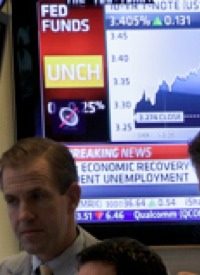
Bloomberg News reports:
The $80 billion initiative, called single-tranche open-market operations, or ST OMO, made 28-day loans from March through December 2008, a period in which confidence in global credit markets collapsed after the Sept. 15 bankruptcy of Lehman Brothers Holdings Inc.
Units of 20 banks were required to bid at auctions for the cash. They paid interest rates as low as 0.01 percent that December, when the Fed’s main lending facility charged 0.5 percent.
Records of the 2008 lending, released in March under court orders, show how the central bank adapted an existing tool for adjusting the U.S. money supply into an emergency source of cash. Zurich-based Credit Suisse borrowed as much as $45 billion, according to bar graphs that … the central bank provided to media organizations that sued the Fed Board of Governors for public disclosure.
Even worse, details of the transactions were not made available to shareholders, nor to members of Congress.
Robert Eisenbeis, former head of research at the Federal Reserve Bank of Atlanta, contends that the news should not come as a surprise to anyone. “This was a pure subsidy,” he remarked. “The Fed hasn’t been forthcoming with disclosures overall. Why should this be any different?”
Bloomberg also reports that the Dodd-Frank financial overhaul bill completely overlooked the program: “Congress overlooked ST OMO when lawmakers required the central bank to publish its emergency lending data last year under the Dodd-Frank law.”
The Dodd-Frank law requires the Federal Reserve to release details of “any open-market operations undertaken after July 2010.”
Representative Barney Frank, Chair of the House Financial Services Committee in 2008 and co-author of the massive legislation, claims that he was wholly unaware of the program.
Meanwhile, the Federal Reserve defends the financial endeavors, indicating that the money helped keep the banks afloat and ensured continuous cash flow for the average citizen.
Jeffrey Smith, spokesman for the New York Fed, said, “This program helped alleviate strains in financial markets and support the flow of credit to U.S. households and businesses.”
As is usual with the Federal Reserve, the details of the transactions are highly secretive and exact loan amounts for each bank cannot be disclosed, says Smith.
However, Bloomberg News was able to estimate the loan amounts for each bank by the graphs that were provided as a result of the Fed’s court-ordered March 31 disclosure under the Freedom of Information Act. The release of the information was mandated by the Supreme Court. Bloomberg LP, the parent company of Bloomberg News and News Corp. sued the Federal Reserve for the information after the Fed refused to release lending records under the Freedom of Information Act.
The Fed defends the secrecy of its open market operations claiming that the disclosure of any information could cause borrowers “substantial competitive harm.” Christopher Burke, vice president of the New York Fed’s markets group, asserts that revealing information regarding the borrowing “could lead market participants to inaccurately speculate that the primary dealer was having difficulty finding term funding against its collateral in the open market and that the dealer itself must therefore be in financial trouble.”
But what is certain, according to Lou Crandall, chief U.S. economist at ICAP LLC, a research company that specializes in Fed operations, is that the program was intended to stimulate trading in mortgage-backed securities. In fact, the banks that received the funds posted mortgage securities that had been guaranteed by government-sponsored enterprises like Fannie Mae or Freddie Mac in exchange for cash from the Federal Reserve.
John Cochrane, finance professor at the University of Chicago Booth School of Business contends that the Federal Reserve far surpassed its reach. “The Fed was slamming the pedal to the metal in the lender-of-last resort category,” Cochrane remarked. “What they did was so far from what we conventionally think of as monetary policy.”
Photo: AP Images




